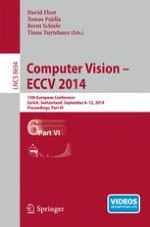2014 | OriginalPaper | Buchkapitel
GIS-Assisted Object Detection and Geospatial Localization
verfasst von : Shervin Ardeshir, Amir Roshan Zamir, Alejandro Torroella, Mubarak Shah
Erschienen in: Computer Vision – ECCV 2014
Verlag: Springer International Publishing
Aktivieren Sie unsere intelligente Suche, um passende Fachinhalte oder Patente zu finden.
Wählen Sie Textabschnitte aus um mit Künstlicher Intelligenz passenden Patente zu finden. powered by
Markieren Sie Textabschnitte, um KI-gestützt weitere passende Inhalte zu finden. powered by
Geographical Information System (GIS) databases contain information about many objects, such as traffic signals, road signs, fire hydrants, etc. in urban areas. This wealth of information can be utilized for assisting various computer vision tasks. In this paper, we propose a method for improving object detection using a set of priors acquired from GIS databases. Given a database of object locations from GIS and a query image with metadata, we compute the expected spatial location of the visible objects in the image. We also perform object detection in the query image (e.g., using DPM) and obtain a set of candidate bounding boxes for the objects. Then, we fuse the GIS priors with the potential detections to find the final object bounding boxes. To cope with various inaccuracies and practical complications, such as noisy metadata, occlusion, inaccuracies in GIS, and poor candidate detections, we formulate our fusion as a higher-order graph matching problem which we robustly solve using RANSAC. We demonstrate that this approach outperforms well established object detectors, such as DPM, with a large margin.
Furthermore, we propose that the GIS objects can be used as cues for discovering the location where an image was taken. Our hypothesis is based on the idea that the objects visible in one image, along with their relative spatial location, provide distinctive cues for the geo-location. In order to estimate the geo-location based on the generic objects, we perform a search on a dense grid of locations over the covered area. We assign a score to each location based on the similarity of its GIS objects and the imperfect object detections in the image. We demonstrate that over a broad urban area of >10 square kilometers, this semantic approach can significantly narrow down the localization search space, and occasionally, even find the correct location.
